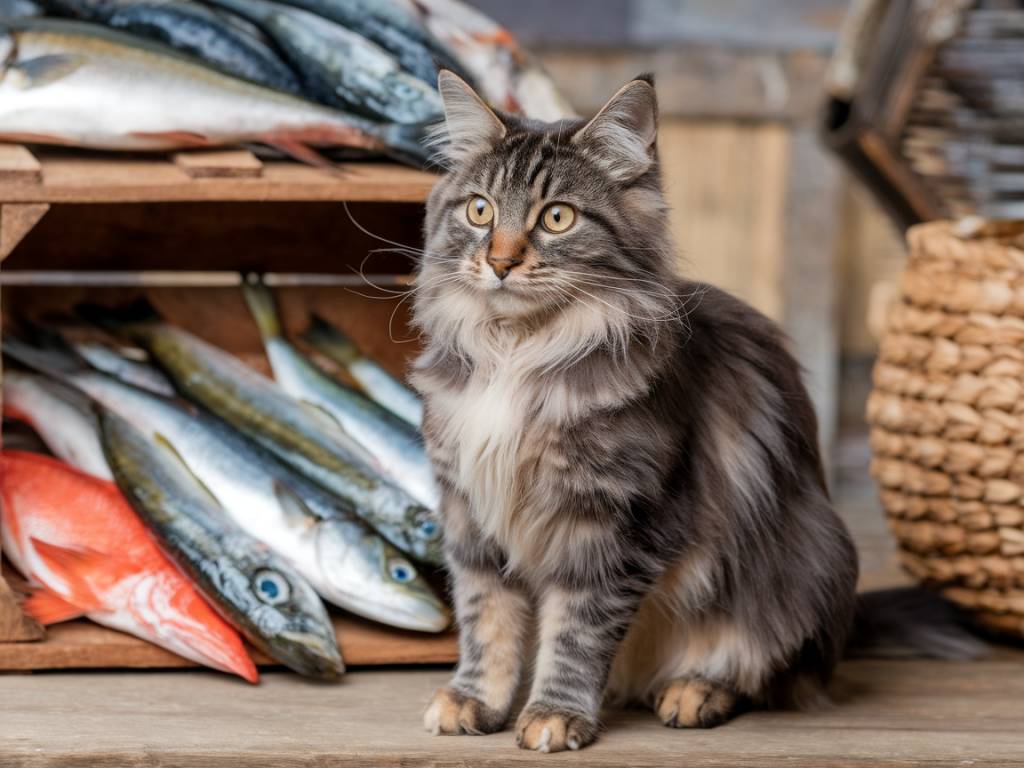Understanding Omega-3 Fatty Acids
For cat owners aiming to provide the best nutrition for their feline companions, understanding the role of essential nutrients is crucial. Omega-3 fatty acids are vital components in a cat’s diet that contribute significantly to their overall health, particularly the health of their skin and fur. These fats are not only pivotal for the coat’s shine and strength but also for various bodily functions.
Omega-3 fatty acids are a type of polyunsaturated fat, important for cellular membrane integrity and physiological processes. Commonly found in fish oil, krill oil, and certain plant oils, these fatty acids comprise three main types: ALA (alpha-linolenic acid), EPA (eicosapentaenoic acid), and DHA (docosahexaenoic acid). While ALA is primarily sourced from plants, EPA and DHA are abundant in marine sources.
The Role of Omega-3 in Skin and Coat Health
Cats, like humans, cannot synthesize omega-3 fatty acids and must obtain them through their diet. In feline nutrition, omega-3s are celebrated for their anti-inflammatory properties, which directly impact skin health. Inflammation of the skin can lead to various dermatological issues, including itchiness, redness, and even hair loss.
Feeding cats optimal levels of omega-3s helps maintain a robust and glossy coat. This is because these fatty acids are integrated into the skin’s lipid barrier, which keeps it moisturized and resilient against external aggressors and allergens. Moreover, omega-3s improve follicle health and promote fur regeneration, reducing the incidence of matting and dandruff.
Benefits Beyond Skin and Fur
While the primary focus here is skin and fur, the benefits of omega-3 fatty acids extend beyond aesthetics. These nutrients contribute to:
- Joint Health: Omega-3s have anti-inflammatory effects that can alleviate joint pain and improve mobility in aging cats or those with arthritis.
- Heart Health: These fats support cardiovascular function, reducing the risk of heart diseases by lowering triglycerides and improving artery health.
- Immune Function: Omega-3 fatty acids enhance the immune response, helping cats to fight off infections and recover more swiftly from illnesses.
- Brain Development: Particularly DHA plays a crucial role in brain health and cognitive function, important for both kittens and senior cats.
Sourcing Omega-3s in Cat Diets
To ensure your cat receives adequate omega-3s, consider the various dietary sources available. Fish oil is among the most potent, with salmon oil and sardine oil providing rich amounts of EPA and DHA. These can be given in supplement form, specifically designed for pets to balance their diet.
Additionally, some commercial cat foods are now formulated with added omega-3 fatty acids. When choosing such foods, it’s vital to look for high-quality products that specify sources like fish or krill oil rather than generic « fishmeal. » This helps ensure bioavailability and effectiveness.
Dosage and Precautions
While omega-3s are beneficial, it’s crucial to administer the right dosage. Overconsumption can lead to potential health issues such as diarrhea, reduced clotting, and increased bleeding tendency. Hence, consulting with a veterinarian is recommended to tailor dosages specific to your cat’s age, weight, and health status.
For pet owners opting for supplements, it’s wise to start with a low dosage and adjust gradually, observing how your cat responds. Monitoring the quality of the supplement is equally vital; opt for reputable brands that rigorously test their products for purity and potency.
Addressing Individual Needs
Cats, like people, have individual dietary needs that may vary depending on their breed, age, and health conditions. Cats with certain medical issues, such as allergies or autoimmune diseases, may benefit from higher levels of omega-3s due to their anti-inflammatory effects. Meanwhile, breeds with naturally dense coats, like Maine Coons or Persians, might require more omega-3s to maintain their luxurious fur.
For kittens and young cats, omega-3s are critical for development, supporting brain growth and vision. Senior cats, on the other hand, may require them for maintaining cognitive function and joint health.
How to Introduce Omega-3s to Your Cat’s Diet
If you’re new to introducing omega-3s into your cat’s diet, consider starting with small amounts of fish oil mixed into their regular meals. Some cats may be sensitive to changes in their diet, so gradual introduction helps prevent any digestive upset.
Observe your cat’s reaction. Notice any changes in their coat’s texture or shine, reduction in skin irritations, or improvement in mobility if they had joint issues. Positive changes may take time, often several weeks, to become evident. Consistency in supplementation and adherence to recommended amounts is key to effectiveness.
Moreover, conduct regular check-ups with your veterinarian to ensure that your cat’s nutritional needs are met and that there are no adverse reactions to dietary changes.
In conclusion, prioritizing omega-3 fatty acids in your cat’s diet is a proactive approach toward enhancing their overall well-being. These fats play a crucial role not only in maintaining a healthy coat and skin but also in supporting cardiovascular, joint, and immune health. By choosing the right foods and supplements and consulting with a veterinarian, you can significantly improve your feline friend’s quality of life, proving that a little fat can go a long way in their journey to healthy skin and fur.
Lisa Tissed

